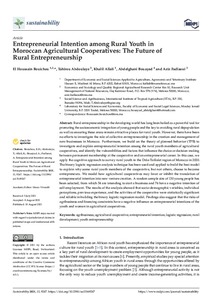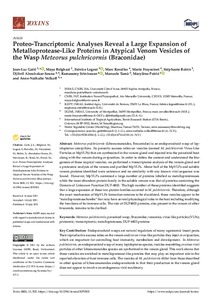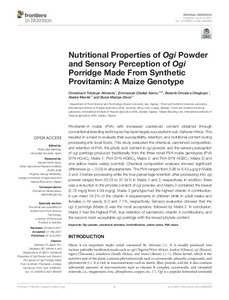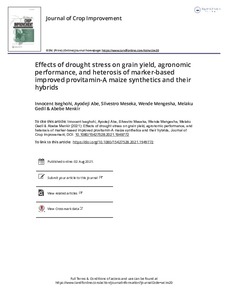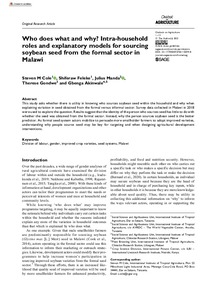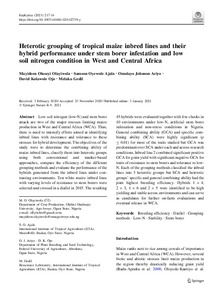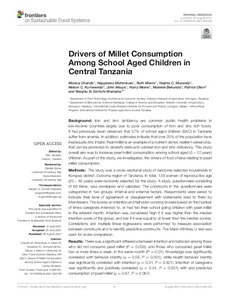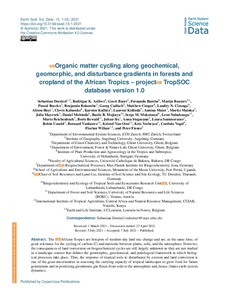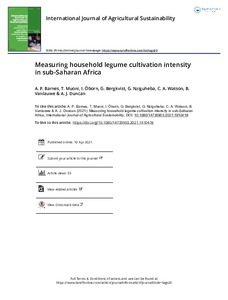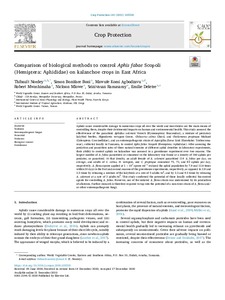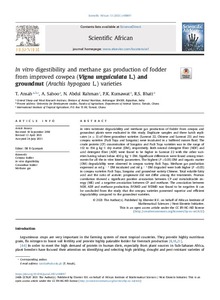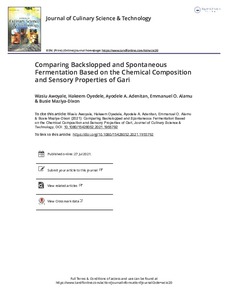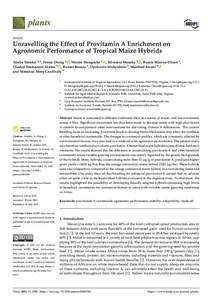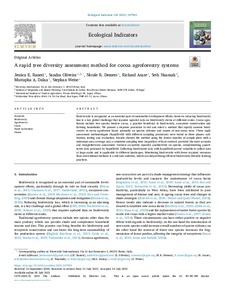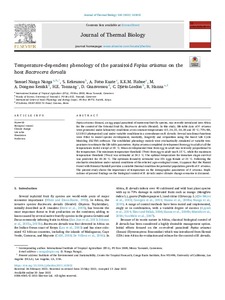Welcome to the International Institute of Tropical Agriculture Research Repository
Journal and Journal Articles: Recent submissions
Now showing items 1001-1020 of 5271
-
Entrepreneurial intention among rural youth in Moroccan Agricultural Cooperatives: the future of rural entrepreneurship
(2021)Rural entrepreneurship in the developing world has long been hailed as a powerful tool for promoting the socioeconomic integration of young people and the key to avoiding rural depopulation as well as ensuring these areas remain attractive places for rural youth. However, there have been no efforts to investigate the role of collective entrepreneurship in the creation and management of new businesses in Morocco. Furthermore, we build on the theory of planned behavior (TPB) to investigate and explain ... -
Life cycle assessment of animal-based foods and plant-based protein-rich alternatives: an environmental perspective
(2021)BACKGROUND In the European Union proteins for food are largely animal based, consisting of meat and dairy products. Almost all soy but also a larger part of pulses and cereals consumed in the European Union are used for animal nutrition. While livestock is an important source of proteins, it also creates substantial environmental impacts. The food and feed system is closely linked to the planetary and health boundaries and a transformation to healthy diets will require substantial dietary shifts ... -
Agro-morphological characterization of Arabica coffee cultivars in Burundi
(2021)Background and Objective: Arabica coffee is an important beverage crop in world trade. The crop is gaining increasing importance in Burundi as an export crop. This study aimed to evaluate diversity among coffee cultivars based on quantitative agro-morphological traits for developing superior cultivars in Burundi. Materials and Methods: Fifteen coffee accessions including five commercial cultivars) were used in the study. From each accession, data were collected from three randomly selected trees ... -
Proteo-trancriptomic analyses reveal a large expansion of metalloprotease-like proteins in atypical venom vesicles of the wasp Meteorus pulchricornis (Braconidae)
(2021-07-19)Meteorus pulchricornis (Ichneumonoidea, Braconidae) is an endoparasitoid wasp of lepidopteran caterpillars. Its parasitic success relies on vesicles (named M. pulchricornis Virus-Like Particles or MpVLPs) that are synthesized in the venom gland and injected into the parasitoid host along with the venom during oviposition. In order to define the content and understand the biogenesis of these atypical vesicles, we performed a transcriptome analysis of the venom gland and a proteomic analysis of the ... -
Nutritional properties of ogi powder and sensory perception of ogi porridge made from synthetic provitamin: A maize genotype
(2021)Provitamin-A maize (PVA) with increased carotenoid content obtained through conventional breeding techniques has been largely successful in sub-Saharan Africa. This resulted in a need to evaluate their susceptibility, retention, and nutritional content during processing into local foods. This study evaluated the chemical, carotenoid composition, and retention of PVA, the phytic acid content in ogi powder, and the sensory perception of ogi porridge produced traditionally from the three novel PVA ... -
Reproduction potential of Nigerian Meloidogyne spp. and the response of six commercial watermelon cultivars to predominant species
(2021)The reproduction potential of nine single-species Meloidogyne populations and 16 mixed-species communities, recovered from watermelon rhizospheres in South-West Nigeria, were determined in roots of tomato (cv. Tropimech) in a glasshouse. The host responses of six commercial watermelon cultivars were also assessed under glasshouse conditions to single-species populations of Meloidogyne incognita, M. javanica and M. enterolobii. Reproduction potential of different Meloidogyne populations and the ... -
Effects of drought stress on grain yield, agronomic performance, and heterosis of marker-based improved provitamin-A maize synthetics and their hybrids
(2021)Provitamin A-enriched maize (Zea mays L.) is an important complementary food staple for combating vitamin A deficiency (VAD) in high maize-producing and maize-consuming countries of sub-Saharan Africa (SSA). However, frequent drought is a major abiotic factor that retards maize growth, resulting in yearly fluctuations in grain yield. Development of provitamin A-enriched maize varieties resilient to recurrent drought stress could enhance and stabilize maize grain yield. This study was conducted to ... -
Understanding nutrient imbalances in maize (Zea mays L.) using the diagnosis and recommendation integrated system
(2021)Low nutrient use efficiency in maize as a result of imbalanced nutrition has been reported to drastically reduce yield. We implemented a nutrient omission experiment to assess the effect of nutrient application on maize yield and nutritional balance. Maize ear leaves were analyzed for nutrients, to identify nutrient balance status using the Diagnostic and Recommendation Integrated System (DRIS) approach. Results indicated that omission of N or P resulted in highly imbalanced DRIS indices respectively, ... -
Who does what and why? Intra-household roles and explanatory models for sourcing soybean seed from the formal sector in Malawi
(2021-08-02)This study asks whether there is utility in knowing who sources soybean seed within the household and why when explaining variation in seed obtained from the formal versus informal sector. Survey data collected in Malawi in 2018 were used to explore the question. Results suggest that the identity of the person who sources seed has little to do with whether the seed was obtained from the formal sector. Instead, why the person sources soybean seed is the better predictor. As formal seed system actors ... -
Heterotic grouping of tropical maize inbred lines and their hybrid performance under stem borer infestation and low soil nitrogen condition in west and central Africa
(2021)Low soil nitrogen (low-N) and stem borer attack are two of the major stresses limiting maize production in West and Central Africa (WCA). Thus, there is need to intensify efforts aimed at identifying inbred lines with resistance and tolerance to these stresses for hybrid development. The objectives of the study were to determine the combining ability of maize inbred lines, classify them into heterotic groups using both conventional and marker-based approaches, compare the efficiency of the different ... -
Drivers of millet consumption among school aged children in central Tanzania
(2021)Background: Iron and zinc deficiency are common public health problems in low-income countries largely due to poor consumption of iron and zinc rich foods. It has previously been observed that 57% of school aged children (SAC) in Tanzania suffer from anemia. In addition, estimates indicate that over 25% of the population have inadequate zinc intake. Pearlmillet is an example of a nutrient dense, resilient cereal crop, that can be promoted to diversify diets and combat iron and zinc deficiency. ... -
Organic matter cycling along geochemical, geomorphic and disturbance gradients in forests and cropland of the African Tropics - project TropSOC database version 1.0
(2021)The African Tropics are hotspots of modern-day land-use change and are, at the same time, of great relevance for the cycling of carbon (C) and nutrients between plants, soils and the atmosphere. However, the consequences of land conversion on biogeochemical cycles are still largely unknown as they are not studied in a landscape context that defines the geomorphic, geochemically and pedological framework in which biological processes take place. Thus, the response of tropical soils to disturbance ... -
Measuring household legume cultivation intensity in sub-Saharan Africa
(2021)Legumes form part of an ecological-based solution to intensification in areas with limited access to external inputs. Despite a number of decades of intervention, uptake of legumes has been slow within smallholder farming systems in sub-Saharan Africa. We explore the drivers behind the adoption of legumes by developing an indicator of household legume cultivation (HLC) from a bespoke survey of small-scale farm households in Kenya and the Democratic Republic of the Congo. A beta regression framework ... -
Comparison of biological methods to control Aphis fabae Scopoli (Hemiptera: Aphididae) on kalanchoe crops in East Africa
(2021)Aphids cause considerable damage to numerous crops all over the world and insecticides are the main means of controlling them, despite their detrimental impacts on human and environmental health. This study assessed the effectiveness of the parasitoid Aphidius colemani Viereck (Hymenoptera: Braconidae), a mixture of predatory ladybird beetles, Hippodamia variegata Goeze, Chilocorus calvus Chiccl, and Cheilomenes propinqua Mulsant (Coleoptera: Coccinellidae), and an entomopathogenic strain of ... -
In vitro digestibility and methane gas production of fodder from improved cowpea (Vigna unguiculata L.) and groundnut (Arachis hypogaea L.) varieties
(2021-09)In vitro substrate degradability and methane gas production of fodder from cowpea and groundnut plants were evaluated in this study. Duplicate samples and three batch replicates (n = 3) of three groundnut varieties (Samnut 22, Chinese and Samnut 23) and two cowpea varieties (Padi Tuya and Songotra) were incubated in a buffered rumen fluid. The crude protein (CP) concentration of Songotra and Padi Tuya varieties was in the range of 112 to 154 g kg−1 dry matter (DM), respectively. Both neutral ... -
Comparing backslopped and spontaneous fermentation based on the chemical composition and sensory properties of gari
(2021-07-27)The backslopped cassava mash (BCM) produced by pre-fermenting grated cassava for 96 h was mixed with fresh cassava mash from the same variety using different blend ratios and processed to backslopped fermented gari (BFG). Another batch of the same variety was fermented for 24 h, 48 h, 72 h, and 96 h to get spontaneous fermented gari (SFG). Standard methods were used to analyze the chemical composition and sensory properties of the samples. Results showed that the moisture, fat, and CNP contents, ... -
Impact of type and level of stabilizers and fermentation period on the nutritional, microbiological, and sensory properties of short-set Yoghurt
(2021-08-04)This study aimed to produce short set yoghurt with different stabilizers at different concentrations and determine the effects of the stabilizers and length of fermentation on the nutritional, microbiological, and sensory properties of short set yoghurt. Stabilized yoghurt samples were produced using 0%, 0.5%, and 1.0% concentrations of carboxyl methylcellulose (CMC), corn starch, and gum acacia with different fermentation periods (1–5 hr), respectively. Samples were analyzed for the proximate, ... -
Unravelling the effect of provitamin A enrichment on agronomic performance of tropical maize hybrids
(2021-07-31)Maize is consumed in different traditional diets as a source of macro- and micro-nutrients across Africa. Significant investment has thus been made to develop maize with high provitamin A content to complement other interventions for alleviating vitamin A deficiencies. The current breeding focus on increasing β-carotene levels to develop biofortified maize may affect the synthesis of other beneficial carotenoids. The changes in carotenoid profiles, which are commonly affected by environmental ... -
A rapid tree diversity assessment method for cocoa agroforestry systems
(2021-07-28)Biodiversity is recognized as an essential part of sustainable development efforts, however reducing biodiversity loss is a key global challenge that requires updated data on biodiversity status at different scales. Cocoa agroforests include tree species besides cocoa, a practice beneficial to biodiversity, ecosystem conservation and farming households. We present a stepwise procedure to test and select a method that rapidly assesses biodiversity in cocoa agroforests based primarily on species ... -
Temperature-based phenology model to predict the development, survival, and reproduction of the oriental fruit fly Bactrocera dorsalis
(2021-04)The oriental fruit fly Bactrocera dorsalis (Diptera: Tephritidae) is a major pest of fruit and vegetable production systems on several continents. The pest has invaded many countries, causing considerable impact on fruit production systems and commercialization. In this study we determined the relationship between temperature and development, survival and reproductive parameters of B. dorsalis on an artificial diet under laboratory conditions under 7 constant temperatures (10, 15, 20, 25, 30, 33 ...

